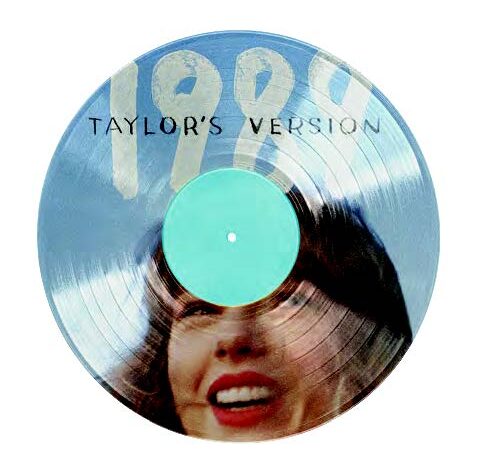
Album Review: ‘1989 (Taylor’s Version)’falls short of original
By Elijah Nevlin
ON Oct. 27, Taylor Swift unveiled her newest album, a “Taylor’s Version” re-recording of 2014’s “1989.”
The rights to the master recordings for Taylor Swift’s first six albums were sold without her consent in 2019, leaving her without control over her own music. In response, she began to re-record the affected albums in an effort to gain full control. “1989” is the latest Swift record to get this treatment.
In theory, these albums are re-recorded with the intention of bringing power to the person and fighting against the system that puts these restrictions on musicians. However, these issues affect smaller artists much more than huge stars. Taylor Swift is a billionaire, one of the most successful musicians of all time, and she notably profits from listeners regardless of which version is purchased.
Considering that Swift still makes money from the original albums, is there truly a reason to stream these re-recordings? Well, only if the “Taylor’s Version” improves on the original in some way.
These recordings do not accomplish such a task.
While Swift usually goes through great lengths to assemble a high-budget and high-quality album for “Taylor’s Version,” “1989” falls flat on its face in terms of production. The mixing and mastering are both of poor quality and not at all what should be expected of such a profitable album.
For some songs, the re-recording is a very faithful adaptation of the original; differences are barely noticeable. Hits like “Style” are sorely missing the attention to detail that the original provides, as the once-crisp chorus is transformed into a muffled Swift singing over a vaguely melodic blob. “New Romantics” was once a superbly paced, energetic pop song. In “Taylor’s Version,” the song feels rushed in an unpleasant way.
“All You Had To Do Was Stay,” once an impressively and evenly spread production, now sounds like layers of a song stacked on top of each other. Backing vocals that shout the word “stay” were once balanced with the instrumental. Now, the vocals are barely comprehensible, as the enunciation has been overshadowed in a poorly mixed re-creation that places too little emphasis on making the vocals sound clear.
Even in songs where the instrumental sounds great, like “Bad Blood,” the vocals take a blatant hit in quality. Multiple songs on “1989 (Taylor’s Version)” have muffled vocals in some form, as if Swift cheapened out on her recording equipment. This problem is prevalent across much of the album. Swift is one of the richest artists in the world and “1989” is one of the most successful albums of the 2010s, yet the production quality of this album does not reflect the high budget it deserved.
Some songs on this album, like “I Know Places” and “Clean,” are recreated wonderfully. The background vocals on “Clean” are actually clearer than they were previously, making it the one song that improved the original, although the production is otherwise muddy. As someone who loves the original “1989” with all my heart, this release is not for me.
Through the past few years, Swift has become even more famous than she already was.
The Eras Tour was a huge success that ushered in the Taylor Swift monolith, and “1989 (Taylor’s Version)” is the first true release since her newfound boom period. This album is not intended for pre-existing “Swifties” who already love her music. This album and arguably many of her re-recordings target new fans.
I have spent countless hours with “1989.” It is one of my favorite albums of all time and I know the album much more intimately than the average fan. I cannot say that these re-recordings are better than the originals, nor will I ever prefer listening to them.
However, a new fan who has never heard “1989” before or only knows a few songs may never notice the difference. Seeing how successful these re-recordings are, it is clear that Swift is essentially re-selling her most successful albums to new batches of fans and reaping the benefits as if there were new albums entirely.
If the re-recordings do not intend to appeal to die-hard fans, then what does? Well, the album includes five new “vault” songs. “Slut!” is rather boring and sounds more like a “Midnights” castoff than something from “1989.” “Suburban Legends,” “Is It Over Now?” and “Now That We Don’t Talk” all have a similar problem, leaving the listener wondering if these songs are really from 2014 at all. For someone looking for more of the “1989” sound, there is a lot left to be desired. There is just one truly strong track, titled “Say Don’t Go.” The Diane Warren collaboration is vibrant in a way that the other “vault” tracks are not.
Overall, “1989 (Taylor’s Version)” depicts a cynical re-creation of an already beloved album. Swift maximizes profits by owning the masters that she can market towards a fresh generation of fans while minimizing the money or effort spent on matching the original in quality. While 2014’s “1989” is an incredible pop album, “Taylor’s Version” falls quite short of expectations. Production is weak and muddy, the vocals sound hollow and cheap, and the new songs sound much newer than they should. I am disappointed in the new Taylor Swift release, and can only hope that future re-recordings succeed where “1989” has failed.



